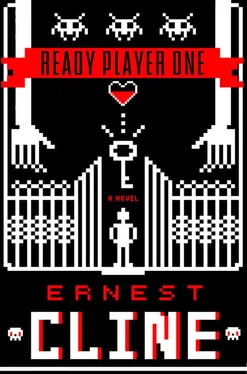I leapt up on the table and jumped inside.
I found myself standing just inside the entrance of a seedy-looking bowling alley with disco-era decor. The carpet was a garish pattern of green and brown swirls, and the molded plastic chairs were a faded orange color. The bowling lanes were all empty and unlit. The place was deserted. There weren’t even any NPCs behind the front counter or the snack bar. I wasn’t sure where I was supposed to be until I saw MIDDLETOWN LANES printed in huge letters on the wall above the bowling lanes.
At first, the only sound I heard was the low hum of the fluorescent lights overhead. But then I noticed a series of faint electronic chirps emanating from off to my left. I glanced in that direction and saw a darkened alcove just beyond the snack bar. Over this cavelike entrance was a sign. Eight bright red neon letters spelled out the words GAME ROOM.
There was a violent rush of wind, and the roar of what sounded like a hurricane tearing through the bowling alley. My feet began to slide across the carpet, and I realized that my avatar was being pulled toward the game room, as if a black hole had opened up somewhere in there.
As the vacuum yanked me through the game room entrance, I spotted a dozen videogames inside, all from the mid- to late ’80s. Crime Fighters, Heavy Barrel, Vigilante, Smash TV. But I could now see that my avatar was being drawn toward one game in particular, a game that stood alone at the very back of the game room.
Black Tiger. Capcom, 1987.
A swirling vortex had opened in the center of the game’s monitor, and it was sucking in bits of trash, paper cups, bowling shoes—everything that wasn’t nailed down. Including me. As my avatar neared it, I reflexively reached out and grabbed the joystick of a Time Pilot machine. My feet were instantly lifted off the floor as the vortex continued to pull my avatar inexorably toward it.
At this point, I was actually grinning in anticipation. I was all prepared to pat myself on the back, because I’d mastered Black Tiger long ago, during the first year of the Hunt.
In the years prior to his death, when Halliday had been living in seclusion, the only thing he’d posted on his website was a brief looping animation. It showed his avatar, Anorak, sitting in his castle’s library, mixing potions and poring over dusty spellbooks. This animation had run on a continuous loop for over a decade, until it was finally replaced by the Scoreboard on the morning Halliday died. In that animation, hanging on the wall behind Anorak, you could see a large painting of a black dragon.
Gunters had filled countless message board threads arguing about the meaning of the painting, about what the black dragon signified or whether it signified anything at all. But I’d been sure of its meaning from the start.
In one of the earliest journal entries in Anorak’s Almanac , Halliday wrote that whenever his parents would start screaming at each other, he would sneak out of the house and ride his bike to the local bowling alley to play Black Tiger, because it was a game he could beat on just one quarter. AA 23:234: “For one quarter, Black Tiger lets me escape from my rotten existence for three glorious hours. Pretty good deal.”
Black Tiger had first been released in Japan under its original title Burakku Doragon . Black Dragon. The game had been renamed for its American release. I’d deduced that the black dragon painting on the wall of Anorak’s study had been a subtle hint that Burakku Doragon would play a key role in the Hunt. So I’d studied the game until, like Halliday, I could reach the end on just one credit. After that, I continued to play it every few months, just to keep from getting rusty.
Now, it looked as if my foresight and diligence were about to pay off.
I was only able to hold on to the Time Pilot joystick for a few seconds. Then I lost my grip and my avatar was sucked directly into the Black Tiger game’s monitor.
Everything went black for a moment. Then I found myself in surreal surroundings.
I was now standing inside a narrow dungeon corridor. On my left was a high gray cobblestone wall with a mammoth dragon skull mounted on it. The wall stretched up and up, vanishing into the shadows above. I couldn’t make out any ceiling. The dungeon floor was composed of floating circular platforms arranged end to end in a long line that stretched out into the darkness ahead. To my right, beyond the platforms’ edge, there was nothing—just an endless, empty black void.
I turned around, but there was no exit behind me. Just another high cobblestone wall, stretching up into the infinite blackness overhead.
I looked down at my avatar’s body. I now looked exactly like the hero of Black Tiger—a muscular, half-naked barbarian warrior dressed in an armored thong and a horned helmet. My right arm disappeared in a strange metal gauntlet, from which hung a long retractable chain with a spiked metal ball on the end. My right hand deftly held three throwing daggers. When I hurled them off in the black void at my right, three more identical daggers instantly appeared in my hand. When I tried jumping, I discovered that I could leap thirty feet straight up and land back on my feet with catlike grace.
Now I understood. I was about to play Black Tiger, all right. But not the fifty-year-old, 2-D, side-scrolling platform game that I had mastered. I was now standing inside a new, immersive, three-dimensional version of the game that Halliday had created.
My knowledge of the original game’s mechanics, levels, and enemies would definitely come in handy, but the game play was going to be completely different, and it would require an entirely different set of skills.
The First Gate had placed me inside one of Halliday’s favorite movies, and now the Second Gate had put me inside one of his favorite videogames. While I was pondering the implication of this pattern, a message began to flash on my display: GO!
I looked around. An arrow etched into the stone wall on my left pointed the way forward. I stretched my arms and legs, cracked my knuckles, and took a deep breath. Then, readying my weapons, I ran forward, leaping from platform to platform, to confront the first of my adversaries.
Halliday had faithfully re-created every detail of Black Tiger’s eight-level dungeon.
I got off to a rough start and lost a life before I even cleared the first boss. But then I began to acclimate to playing the game in three dimensions (and from a first-person perspective). Eventually, I found my groove.
I pressed onward, leaping from platform to platform, attacking in midair, dodging the relentless onslaught of blobs, skeletons, snakes, mummies, minotaurs, and yes, ninjas. Each enemy I vanquished dropped a pile of “Zenny coins” that I could later use to purchase armor, weapons, and potions from one of the bearded wise men scattered throughout each level. (These “wise men” apparently thought setting up a small shop in the middle of a monster-infested dungeon was a fine idea.)
There were no time-outs, and no way for me to pause the game. Once you entered a gate, you couldn’t just stop and log out. The system wouldn’t allow it. Even if you removed your visor, you would remain logged in. The only way out of a gate was to go through it. Or die.
I managed to clear all eight levels of the game in just under three hours. The closest I came to death was during my battle with the final boss, the Black Dragon, who, of course, looked exactly like the beast depicted in the painting in Anorak’s study. I’d used up all of my extra lives, and my vitality bar was almost at zero, but I managed to keep moving and stay clear of the dragon’s fiery breath while I slowly knocked down his life meter with a steady barrage of throwing daggers. When I struck the final killing blow, the dragon crumbled into digital dust in front of me.
Читать дальше





![Эрнест Клайн - Ready Player Two [calibre]](/books/438636/ernest-klajn-ready-player-two-calibre-thumb.webp)







